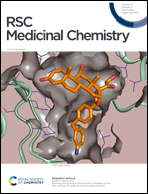Inhibition of N-type calcium channels by phenoxyaniline and sulfonamide analogues†
Abstract
Building on previous investigations, structural modifications to the neuronal calcium ion channel blocker MONIRO-1 and related compounds were conducted that included replacement of the amide linker with an aniline and isosteric sulfonamide moiety, and the previously used strategy of substitution of the guanidinium group with less hydrophilic amine functionalities. A comprehensive SAR study revealed a number of phenoxyaniline and sulfonamide compounds that were more potent or had similar potency for the CaV2.2 and CaV3.2 channel compared to MONIRO-1 when evaluated in a FLIPR-based intracellular calcium response assay. Cytotoxicity investigations indicated that the sulfonamide analogues were well tolerated by Cos-7 cells at dosages required to inhibit both calcium ion channels. The sulfonamide derivatives were the most promising CaV2.2 inhibitors developed by us to date due, possessing high stability in plasma, low toxicity (estimated therapeutic index > 10), favourable CNS MPO scores (4.0–4.4) and high potency and selectivity, thereby, making this class of compounds suitable candidates for future in vivo studies.



 Please wait while we load your content...
Please wait while we load your content...